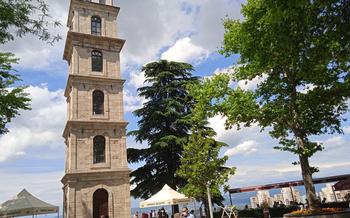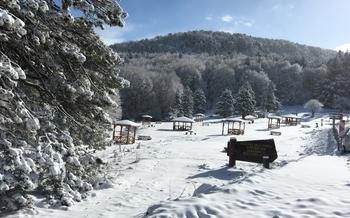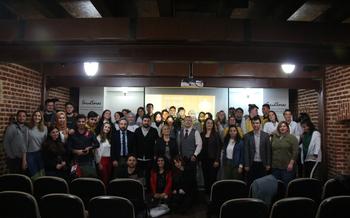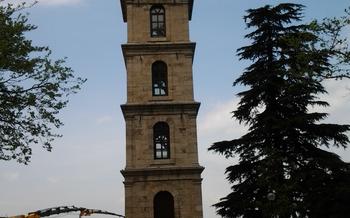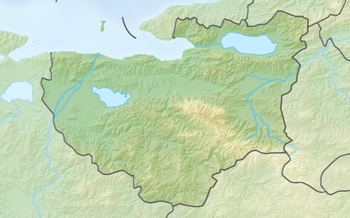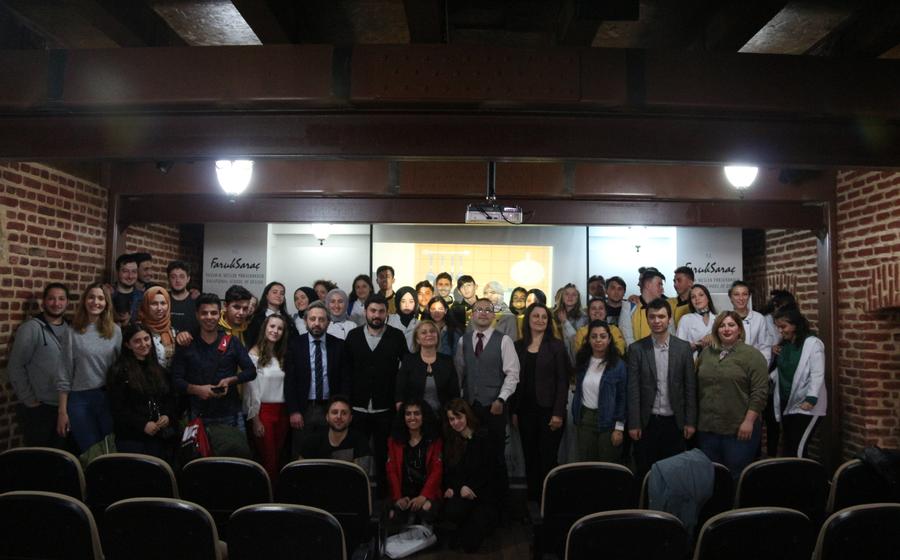
Kite Museum
- Historical Significance:
- Finding the Kite Museum
- Museum Layout and Exhibits
- The History of Kite Flying
- Traditional Turkish Kites:
- International Kite Designs
- The Art of Kite Making
- Kite Flying Demonstrations
- Kite Festival in Bursa
- Souvenirs and Gifts
- Educational Programs
- Photography Opportunities
- Accessibility
- Insider Tip:
Historical Significance:
Bursa, a city steeped in antiquity, has been a pivotal player in Turkish history. As the first capital of the Ottoman Empire, Bursa holds a prominent position in the nation's heritage. The Kite Museum, situated in the heart of this historic city, is a testament to Bursa's vibrant past and its enduring cultural traditions.
Finding the Kite Museum
The Bursa Kite Museum is strategically located at the foot of Uludağ Mountain, approximately 10 kilometers from Bursa city center.
To reach the museum by public transportation, you can take a bus from Bursa Otogar (bus station) to Uluyol. From Uluyol, transfer to another bus heading towards Uludağ. The museum is a short walk from the Uludağ bus stop.
For a more convenient journey, you can hire a taxi from Bursa city center. The fare typically ranges between 50 and 70 Turkish Liras. Alternatively, you can rent a car and enjoy the scenic drive to the museum while exploring Bursa's beautiful surroundings at your own pace.
Museum Layout and Exhibits
The Kite Museum showcases a fascinating array of exhibits spread across two floors. As you enter the ground floor, you will be greeted by a diverse collection of kites from around the world. These kites vary in size, shape, and design, offering a glimpse into the rich cultural heritage associated with kite flying. From traditional Turkish kites to intricate international designs, each kite tells a unique story.
Ascending to the first floor, you will find a section dedicated to the history and evolution of kite flying. Here, you can learn about the origins of kite flying in ancient China and its subsequent spread to various corners of the globe. Interactive displays bring to life the stories of famous kite flyers and showcase the scientific principles behind kite flight.
Throughout the museum, interactive displays provide an engaging and hands-on experience for visitors. You can try your hand at designing and building your own kite, or test your skills at a virtual kite-flying simulator. These interactive elements make the museum a delight for visitors of all ages, encouraging creativity and exploration.
The History of Kite Flying
Kites, with their graceful ascent into the heavens, have a captivating history that spans several civilizations and centuries. Their earliest origins can be traced back to ancient China, where they were initially crafted as religious offerings and decorations. Legend has it that the Chinese philosopher Mozi ingeniously used kites for military signaling and espionage during the 5th century BC.
Kite flying later flourished in the Ottoman Empire, where it became a beloved pastime among sultans and commoners alike. The Ottomans refined kite-making techniques, introducing intricate designs and vibrant colors that reflected their rich artistic traditions. Kites became a symbol of joy and celebration, often flown during festivals and special occasions.
In modern times, kite flying has evolved into a global phenomenon, with enthusiasts from all corners of the world taking to the skies. Kite festivals and competitions are held annually, showcasing the artistry, innovation, and sheer exhilaration of this timeless pursuit.
Traditional Turkish Kites:
Traditional Turkish kites, known as "uçurtma," hold a special place in the country's cultural heritage. These kites are renowned for their intricate designs, vibrant colors, and unique construction techniques that have been passed down through generations.
Crafted from lightweight materials such as mulberry paper or silk, Turkish kites often feature intricate geometric patterns and vibrant hues. The most common shapes include the "uçurtma" (diamond), "çatı" (roof), and "kuş" (bird), each boasting its own distinctive characteristics.
The construction of Turkish kites showcases the skill and artistry of local craftspeople. The frames are meticulously crafted using thin bamboo or wooden sticks, carefully tied together with strong thread or thin wire. The fabric is then stretched over the frame and secured with glue or stitches, creating a lightweight and durable kite.
The designs on Turkish kites are not merely decorative; they often carry cultural and symbolic meanings. Geometric patterns, for instance, are believed to represent the balance and harmony of the universe, while floral motifs symbolize fertility and abundance.
Kite flying in Turkey is more than just a pastime; it is a beloved tradition that brings people together and fosters a sense of community. During festivals and special occasions, the skies above Turkish cities and towns are adorned with a kaleidoscope of colorful kites, creating a spectacle that is both enchanting and awe-inspiring.
International Kite Designs
The Kite Museum in Bursa proudly showcases a vast collection of kites from around the world, showcasing the diverse cultural traditions and artistic expressions associated with this ancient pastime. These international kites represent a kaleidoscope of colors, shapes, and materials, reflecting the unique heritage and creativity of their respective regions.
From the intricate bamboo and silk kites of China to the vibrant paper kites of Japan, each kite carries a story of craftsmanship and cultural significance. Visitors can admire the delicate beauty of the Japanese Rokkaku kite, with its hexagonal shape and vibrant colors, or marvel at the intricate details of the Chinese dragon kite, a symbol of power and good fortune.
The museum also features kites from Southeast Asia, Europe, and the Americas, showcasing the diverse materials and techniques used in kite making worldwide. Visitors can learn about the use of natural materials such as bamboo, wood, and paper, as well as the incorporation of modern materials like synthetic fabrics and lightweight metals.
Each international kite on display tells a story of cultural exchange and global interconnectedness. Whether it's the colorful kites of India, the geometric kites of Thailand, or the realistic kites of Europe, the museum offers a fascinating glimpse into the diverse world of kite flying.
The Art of Kite Making
The Kite Museum offers a unique opportunity for visitors to delve into the art of kite making through its kite-making workshops. These workshops are led by skilled instructors who provide step-by-step guidance and assistance throughout the process. Participants are provided with all the necessary materials, including bamboo sticks, fabric, thread, and glue.
Under the watchful eyes of the instructors, participants learn the traditional techniques used to construct kites. They start by selecting the right materials for their kites, depending on the size and design they have in mind. The instructors demonstrate how to cut the bamboo sticks to the desired length and shape, and how to attach them together using thread or glue.
Once the framework is complete, participants move on to covering the kite with fabric. They learn how to select the right fabric for their kite, taking into consideration factors such as weight, durability, and color. The instructors guide them through the process of cutting the fabric to the appropriate size and shape, and then attaching it to the framework using glue or thread.
With the kite's framework and covering complete, participants move on to the final step: adding the tail. The instructors teach them how to make tails of different lengths and shapes, and how to attach them to the kite in a way that will ensure stability and balance during flight.
Throughout the workshop, the instructors share their knowledge and expertise about kite making, offering tips and tricks to help participants create kites that are both beautiful and functional. The workshops are a great way to learn about the traditional art of kite making and to create a unique souvenir to take home.
Kite Flying Demonstrations
The Kite Museum offers a unique experience for visitors to witness the art of kite flying firsthand. The museum's outdoor flying area provides a designated space where kite enthusiasts can showcase their skills and demonstrate the beauty and precision of kite flying.
Kite flying demonstrations are held regularly, allowing visitors to observe experienced kite flyers in action. These demonstrations showcase various kite flying techniques, from basic maneuvers to intricate aerial acrobatics. The museum's instructors and kite experts provide commentary during the demonstrations, explaining the techniques used and the history and significance of kite flying in Turkey.
Kite flying competitions are also held periodically, attracting kite flyers from around the world to compete for prizes and recognition. These competitions offer a thrilling spectacle as participants showcase their creativity and skill in designing and flying their kites.
Whether you are a seasoned kite flyer or a curious observer, the kite flying demonstrations at the Kite Museum offer an unforgettable experience, allowing you to witness the grace and artistry of this ancient tradition.
Kite Festival in Bursa
Held annually, the Bursa Kite Festival is a vibrant celebration of the art and joy of kite flying. Kite flyers from across Turkey and the world gather in Bursa to showcase their breathtaking creations and engage in friendly competitions. The festival is a delightful spectacle, with the sky filled with a myriad of colorful kites of various shapes and sizes, dancing gracefully in the breeze.
Visitors can witness awe-inspiring kite-making demonstrations by master kite makers, learning the intricate techniques and artistry involved in creating these airborne masterpieces. Kite-making competitions are also organized, where participants compete to create the most innovative, aesthetically pleasing, and flight-worthy kites.
The Bursa Kite Festival is not just about competitions; it's a celebration of culture, creativity, and community spirit. Visitors can enjoy live music performances, traditional Turkish dances, and a variety of food stalls offering delicious local delicacies. The festival provides an unforgettable experience for kite enthusiasts and families alike, creating lasting memories that will be cherished for years to come.
Souvenirs and Gifts
The Kite Museum features a well-stocked gift shop where visitors can purchase various kite-themed souvenirs and educational materials to commemorate their visit. A diverse selection of products awaits, including miniature kite replicas, books on kite making and aerodynamics, and postcards showcasing the museum's collection.
For those seeking unique and handmade mementos, the museum collaborates with local artisans to offer hand-painted kites, intricate shadow puppets, and other traditional Turkish crafts. These souvenirs not only serve as reminders of the museum's exhibits but also support local artisans and preserve cultural heritage.
By purchasing these gifts, visitors not only treasure lasting mementos of their time at the Kite Museum but also contribute to the preservation of Turkish kite-making traditions and the promotion of the museum's educational mission.
Educational Programs
The Kite Museum in Bursa offers a range of educational programs, making it an ideal destination for schools and families. These educational programs are meticulously designed to engage students and promote cultural awareness.
School Visits: The museum welcomes school groups, providing guided tours and interactive kite-making workshops tailored to different grade levels. Students learn about the history and significance of kites, discover the science behind their flight, and explore the diverse cultural traditions associated with them.
Kite-Making Workshops: The museum regularly hosts kite-making workshops, open to both adults and children. These hands-on sessions provide participants with all the necessary materials and guidance to create their own kites. Under the supervision of experienced instructors, participants learn the traditional techniques and enjoy the satisfaction of crafting their unique kites.
Cultural Events: The Kite Museum hosts cultural events throughout the year, offering a platform for kite enthusiasts, artisans, and cultural performers to showcase their talents. These events often include kite-flying demonstrations, kite-making competitions, and cultural performances, providing visitors with a comprehensive and immersive experience of kite culture.
Photography Opportunities
The Kite Museum is a treasure trove for photography enthusiasts, offering a variety of captivating subjects to capture with your lens. Inside the museum, the intricate designs and vibrant colors of the kites suspended from the ceiling create a visually stunning spectacle. Each kite is a unique piece of art, showcasing the creativity and craftsmanship of its maker.
Venture to the first floor, and you'll find a dedicated photography exhibition featuring stunning images of kites from around the world. These photographs showcase the diversity of kite designs, from traditional Turkish kites to elaborate creations from international kite festivals.
Step outside the museum, and you'll enter a picturesque outdoor flying area where you can witness the kites in action. The vibrant colors and graceful movements of the kites against the backdrop of the sky make for breathtaking photo opportunities.
Whether you're a professional photographer or simply enjoy capturing beautiful moments, the Kite Museum offers a wealth of subjects to satisfy your creative eye. Don't forget to bring your camera and capture the magic of this unique museum.
Accessibility
The Kite Museum in Bursa is committed to ensuring that all visitors, regardless of their physical abilities, can enjoy the museum's exhibits and programs.
-
Wheelchair Access: The museum is fully wheelchair accessible, with ramps and elevators providing access to all floors and exhibits. Accessible restrooms are also available on each floor.
-
Accessibility for Families: The museum offers a variety of family-friendly amenities, including a dedicated play area for children, stroller parking, and changing tables in the restrooms.
-
Multilingual Signage: The museum's exhibits and signage are presented in both Turkish and English, making it easy for international visitors to understand and appreciate the museum's content.
Insider Tip:
For an unforgettable experience, plan your visit to coincide with the annual Kite Festival in Bursa. This vibrant event attracts kite enthusiasts from around the world, showcasing a mesmerizing array of kites in various shapes, sizes, and colors. Immerse yourself in the excitement as skilled kite flyers demonstrate their mastery, sending their creations soaring into the sky.
Participate in kite-making workshops to learn the art of crafting these beautiful objects. Under the guidance of experienced instructors, you'll discover the techniques used to create traditional Turkish kites and international designs. Unleash your creativity and design your own unique kite to fly in the outdoor flying area.
Don't miss the opportunity to interact with kite experts who share their passion and knowledge about the history, culture, and techniques of kite flying. Engage in conversations, ask questions, and gain insights into the world of kites. Their expertise will enhance your appreciation for this fascinating art form.


